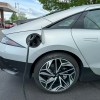
Here’s How GM Is Spending Its $2.25 Billion in ‘Green Bonds’
EVs are quickly taking hold globally thanks to initiatives from a number of countries around the country, the U.S. included. In an effort to create environmentally friendly vehicles, General Motors is one of several automakers globally that has recently issued green bonds to drive investment in its transition to electric vehicles, along with companies like Ford, Honda, and Toyota.
In this article, we’ll discuss what green bonds are and how they work and talk about GM’s plans with their own green bonds to work toward a more sustainable future.
What are green bonds?
A green bond is a fixed-income financial instrument designed primarily to raise funds for climate and environmental projects. Because these bonds are frequently asset-linked and guaranteed by the issuing entity’s balance sheet, they have the same credit rating as the issuer’s other debt obligations.
Green bonds have been referred to as climate bonds since the first decade of the twenty-first century. However, the two concepts are not always synonymous.
Climate bonds finance projects that cut carbon emissions or mitigate the consequences of climate change, whereas green bonds are a larger category of securities that finance initiatives that have a beneficial environmental impact.
How do green bonds work?
Green bonds function similarly to any other company or government bond. Borrowers issue these securities to acquire funding for initiatives that will benefit the environment, such as ecosystem restoration or pollution reduction. Investors who buy these bonds can expect to earn a profit when they mature.
What is GM doing with its green bonds?
GM is pursuing its aim of having its worldwide operations carbon neutral by 2040 and eliminating tailpipe emissions from its new light-duty vehicles by 2035 by creating the ability to construct two million electric vehicles annually by 2025. This all-electric strategy is now bolstered by the first green bond issued in August under GM’s new Sustainable Finance Framework.
The $2.25 billion dual-tranche green bond is issued as the United States approaches a tipping point in electric vehicle usage, with 5% of new car sales powered only by electricity. The bonds consisted of $1 billion in 5.400% senior notes due 2029, and $1.25 billion in 5.600% senior notes due 2032.
To meet rising demand, U.S. automakers have significantly upped their EV investments, which are expected to reach $65 billion by 2027. GM has increased its projected spending on EVs, fuel cells, and self-driving cars to $35 billion by 2025, accounting for nearly half of the expected $65 billion by 2027.
GM allocated the $2.24 billion of net proceeds from the inaugural green bond issuance to Capital Expenditure disbursements that occurred between August 1, 2021 and March 31, 2023.
According to Investor.gm.com, they state that “GM’s line of full-size electric trucks and SUVs currently produced or to be produced in the future at our Factory ZERO and Orion Assembly facilities will significantly reduce the greenhouse gas emission use phase intensity compared to their internal combustion engine counterparts. In some cases, the intensity is reduced up to 70%. We anticipate the intensity will continue to decrease during the use phase through carbon reduction initiatives on the U.S. grid.” Carbon intensity is a measure of how clean our electricity is.
For example, the 2024 Chevrolet Silverado EV intensity is (gCO2e/km) 128 versus the average internal combustion engine pickup truck intensity is (gCO2e/km) 426, which is an intensity reduction of 70%.
GM is going all in when it comes to EV production and sustainability. They have outlined the measures they intend to take in order to align with sustainability efforts in the U.S. as well as globally. Also, to ensure transparency and public reporting on this program, GM will publish an annual sustainable finance report that will be available on its website.


